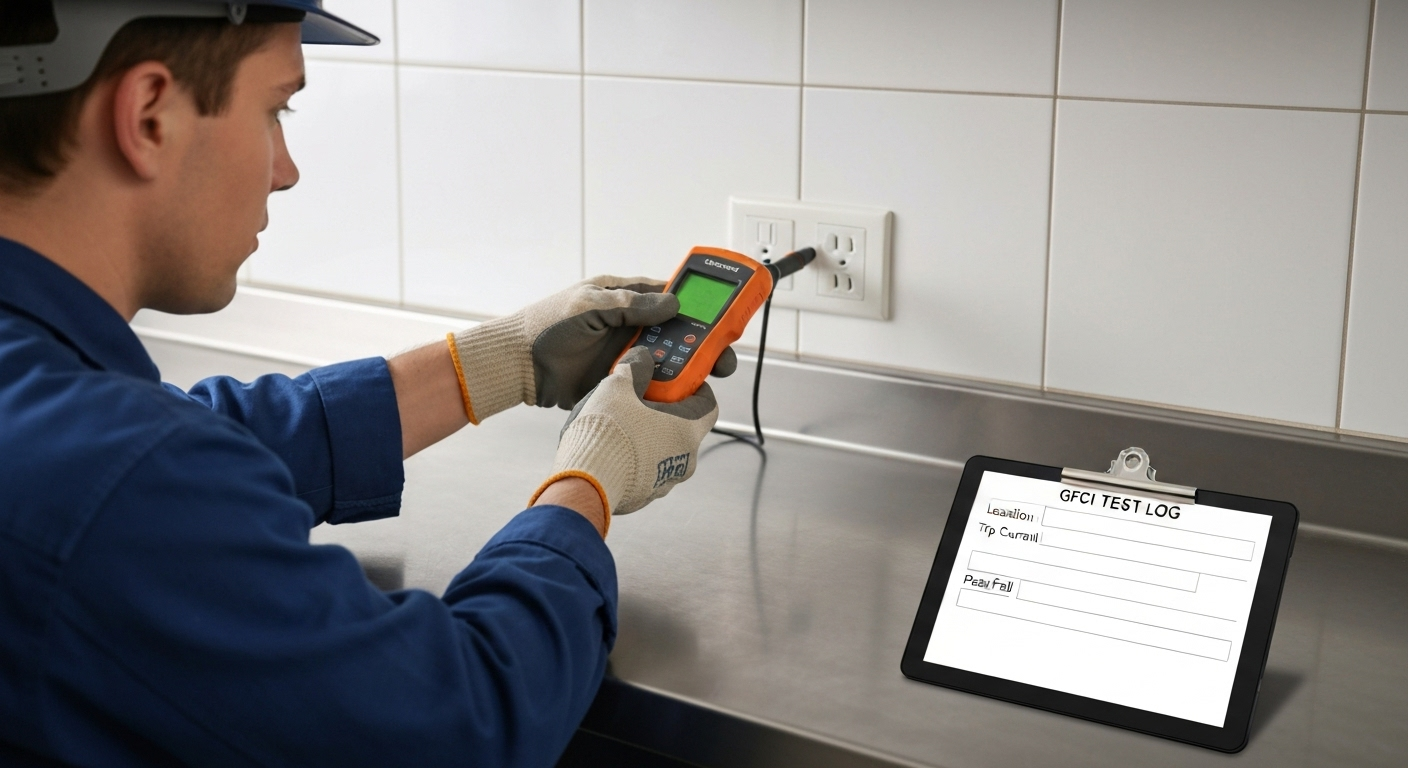
How to Test and Document GFCI Protection for Commercial Jobs
Understanding the Expanded NEC 2023 GFCI Requirements for Commercial Locations
As professional electricians, we know the National Electrical Code (NEC) is a living document. The 2023 cycle brought significant changes, particularly expanding the requirements for ground-fault circuit-interrupter (GFCI) protection in commercial, or “non-dwelling,” locations. For years, the focus was on specific high-risk areas like bathrooms and rooftops. Now, the code has broadened its scope, reflecting a greater emphasis on personnel safety across the board.
Key Changes in NEC 210.8(B)
The core of these changes resides in NEC 210.8(B), “Other Than Dwelling Units.” The 2023 edition now mandates GFCI protection for nearly all receptacles in specific locations, regardless of whether they are near a water source. The major update is the expansion of GFCI protection requirements for all 125-volt through 250-volt receptacles supplied by single-phase branch circuits rated 150 volts or less to ground, 50 amperes or less, and three-phase branch circuits rated 150 volts or less to ground, 100 amperes or less installed in the locations specified in 210.8(B)(1) through (B)(12).
This includes the following 12 locations:
- Bathrooms
- Garages, accessory buildings, service bays, and similar areas
- Outdoors
- Crawl spaces (at or below grade level)
- Unfinished portions or areas of the basement not intended as habitable rooms
- Kitchens
- Laundry areas
- Rooftops
- Sinks (where receptacles are installed within 6 ft from the top inside edge of the bowl)
- Indoor damp locations
- Locker rooms with associated showering facilities
- Areas with sinks and permanent provisions for food preparation or cooking
The takeaway is clear: if you are installing or replacing receptacles in these commercial areas on branch circuits rated 150 volts or less to ground, the NEC 2023 GFCI requirements almost certainly apply. Understanding these expanded rules is the first step toward compliance.
The “Why” Behind GFCI Testing: More Than Just Pushing a Button
Many electricians, and certainly most clients, believe that pushing the “TEST” button on a GFCI receptacle is a sufficient check. While this action is important for routine end-user verification, it is often inadequate for professional GFCI acceptance testing, which aims to verify performance specifications. The button only verifies the mechanical trip function of the device; it does not confirm at what level of current leakage the device will trip.
For true personnel protection, a Class A GFCI must trip when it detects a ground-fault current between 4 and 6 mA, as defined by the UL 943 Standard. A calibrated test instrument is the only way to measure this and ensure the device performs to specification. This quantitative data is what some inspectors and AHJs may require to verify performance, and it serves as proof of a quality installation.
Class A GFCI vs. Equipment Ground-Fault Protection Device (EGFPD)
It’s vital not to confuse a Class A GFCI with an Equipment Ground-Fault Protection Device (EGFPD). While both protect against ground faults, they serve different purposes. A GFCI is a personnel protection system with a low trip threshold (4-6 mA). An EGFPD, often tripping at 30 mA or higher, is designed to protect equipment from damaging fault currents, not to protect people from shock.
Step-by-Step Guide to GFCI Acceptance Testing
Performing and documenting a proper GFCI test is a systematic process. It provides proof of a safe installation and protects you from liability. Here is the recommended procedure for thorough verification.
Equipment Needed:
- A modern, calibrated GFCI circuit tester capable of measuring both trip time and current.
- Appropriate PPE (Personal Protective Equipment).
- A GFCI test log (digital or physical).
The Testing Procedure:
- Visual Inspection: Check the GFCI device for any signs of damage, such as cracks or discoloration. Ensure it is the correct type (e.g., tamper-resistant, weather-resistant) for the location.
- Perform Manual Test: Press the “TEST” button on the GFCI device. The “RESET” button should pop out, and power to the receptacle should be cut. If it fails this simple test, the device is faulty and must be replaced before proceeding.
- Reset the Device: Press the “RESET” button firmly. The indicator light (if present) should turn on, and power should be restored.
- Use the Calibrated Tester: Plug your calibrated GFCI circuit tester into the receptacle. Follow the manufacturer’s instructions. Most advanced testers will first confirm correct wiring (hot, neutral, ground).
- Initiate the Measured Test: Activate the test function on your instrument. The tester will introduce a controlled ground-fault current, ramping it up until the GFCI trips.
- Record Trip Values: The tester will display the exact trip current (in mA) and trip time (in ms). A passing Class A GFCI must trip between 4.0 and 6.0 mA. UL 943 also specifies a maximum trip time based on the fault current, but for the 4-6 mA range, it’s a critical pass/fail metric.
- Document the Results: Immediately record the date, location, device ID, measured trip current, measured trip time, and a pass/fail determination in your GFCI test log.
- Final Reset: Reset the GFCI one last time and verify that any connected equipment powers on, leaving the circuit ready for use.
Creating a GFCI Test Log and Documentation
While not explicitly required by the NEC, detailed compliance documentation is a professional best practice. A well-maintained GFCI test log serves as your proof of due diligence for the AHJ, the general contractor, and the building owner. It is highly recommended to create this log for every commercial job.
What to Include in Your GFCI Test Log:
- Project Name and Address
- Date of Test
- Name/ID of the Electrician Performing the Test
- Panel and Circuit Number
- Receptacle Location/Identifier (e.g., “Kitchen, Prep Counter East Wall #1”)
- GFCI Device Type (Receptacle, Breaker) and Model
- Measured Trip Current (mA)
- Measured Trip Time (ms)
- Pass/Fail Status
- Notes (e.g., “Replaced faulty device,” “Initial test failed, passed after rewiring”)
Navigating these expanded GFCI requirements 2023 and their documentation demands precision. To sharpen your skills across all areas of the code, Master electrical calculations with ExpertCE’s NEC courses.
Common Challenges and Best Practices
Even with proper procedures, you may encounter issues. Understanding how to troubleshoot them is the mark of an expert.
Addressing Nuisance Tripping
One of the most common complaints is “nuisance tripping.” This is rarely due to a faulty GFCI. More often, it’s caused by:
- Cumulative Leakage: Multiple appliances on one circuit can have small, acceptable leakage currents that add up to exceed the GFCI’s 4-6 mA threshold.
- Faulty Appliances: An appliance with worn insulation or moisture ingress can create a small ground fault.
- Long Circuit Runs: Very long circuits can have higher inherent capacitive leakage, contributing to the total.
Troubleshooting involves isolating devices one by one to find the source. Never assume the GFCI is “too sensitive”; it’s doing its job as a personnel protection system.
Key Considerations for Commercial GFCI Compliance
- Use a Calibrated Tester for Verification: An uncalibrated instrument is unreliable. To verify performance against UL standards, ensure your tester is certified, typically annually.
- Document Your Test Results: Your GFCI test log is your best defense and proof of professional work.
- Understand the Scope: Be intimately familiar with the 12 locations listed in NEC 210.8(B) and the new voltage/amperage thresholds.
- Educate Your Clients: Explain the ‘why’ behind the testing and the importance of the expanded safety requirements.
- Grounding is Key: A GFCI does not require an equipment grounding conductor to function, but a proper ground is still required by code for most installations. When working on older systems, ensure you are following proper grounding techniques for switches and receptacles.
- Stay Updated: Code changes are constant. Staying on top of updates, like the new demand factors affecting receptacle load calculations, is essential for every professional.
Primary Sources for GFCI Compliance
For direct reference and further study, consult these official sources:
- NFPA 70, National Electrical Code (NEC): The definitive source for all installation requirements. Access the NEC via NFPA.org.
- UL 943, Standard for Ground-Fault Circuit-Interrupters: The product safety standard that defines the performance criteria for GFCIs, including trip thresholds.
Frequently Asked Questions about NEC 2023 GFCI Requirements
What are the main changes to NEC 2023 GFCI requirements for commercial properties?
The primary change in the 2023 NEC is the significant expansion of GFCI requirements in NEC 210.8(B) for non-dwelling units. It now applies to all 125V-250V receptacles on single-phase circuits up to 50A and three-phase circuits up to 100A (where rated 150V or less to ground) in 12 specified locations, including kitchens and other areas not strictly associated with water.
Is the test button on a GFCI receptacle sufficient for commercial job site acceptance testing?
No. The test button only confirms the internal mechanical trip function. For professional GFCI acceptance testing and verification, it is a best practice to use a calibrated GFCI circuit tester that can measure the actual trip current and time to verify the device operates within the 4-6 mA range required by the UL 943 Standard for a Class A GFCI.
What information must be included in a GFCI test log for compliance?
A comprehensive GFCI test log should include the project name, test date, electrician’s name, receptacle location/ID, panel/circuit info, the measured trip current (mA), the measured trip time (ms), and a clear Pass/Fail result. While not an NEC requirement, this compliance documentation is a best practice and may be requested by the AHJ or building owner for their records.
Where does NEC 210.8(B) require GFCI protection in non-dwelling locations?
NEC 210.8(B) requires GFCI protection for applicable receptacles in 12 specified non-dwelling locations. These are: (1) Bathrooms, (2) Kitchens, (3) Rooftops, (4) Outdoors, (5) Sinks (within 6 ft), (6) Indoor damp locations, (7) Locker rooms with showers, (8) Garages and service bays, (9) Crawl spaces, (10) Unfinished basements, (11) Laundry areas, and (12) Areas with sinks and food/beverage prep or cooking provisions.
Continuing Education by State
Select your state to view board-approved continuing education courses and requirements:
Disclaimer: The information provided in this educational content has been prepared with care to reflect current regulatory requirements for continuing education. However, licensing rules and regulations can vary by state and are subject to change. While we strive for accuracy, ExpertCE cannot guarantee that all details are complete or up to date at the time of reading. For the most current and authoritative information, always refer directly to your state’s official licensing board or regulatory agency.



